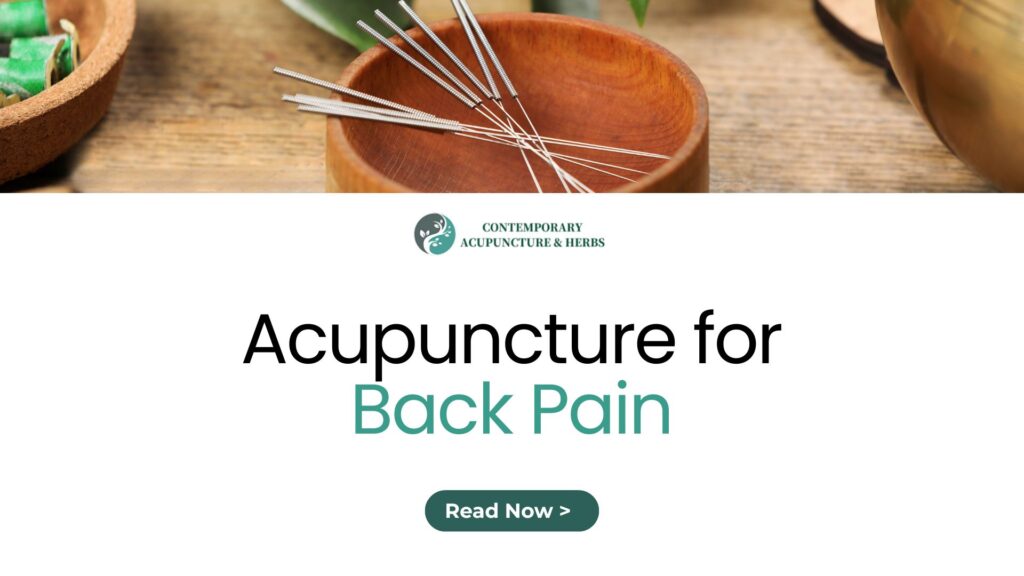Back pain touches so many lives. It could come from long hours at a desk, physical strain, or the natural changes that come with age.
We see how it limits movement, interrupts sleep, and affects daily comfort. For many, it becomes more than a physical challenge. It’s something that weighs on both body and mind.
Acupuncture has been trusted for centuries to ease pain and restore balance, and today it is also supported by growing scientific research as a natural option for managing back pain.
In this guide, we want to share how acupuncture can help. We’ll explain what happens in a treatment, the science behind it, what you can expect from sessions, and how it may fit into a broader plan for long-term back health.
Our goal is to give you clear, balanced information so you can make the best choices for your well-being.
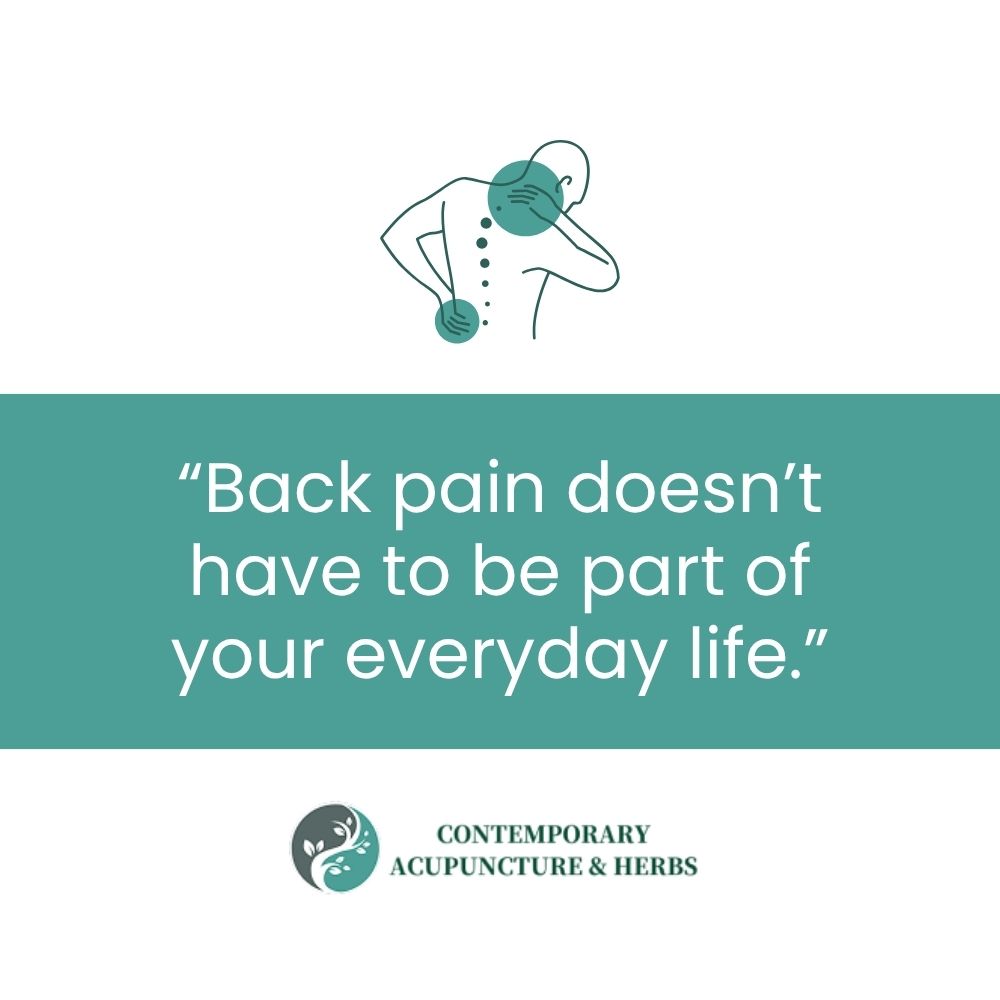
Find Gentle Relief That Lasts
Back pain doesn’t have to be part of your everyday life. Through acupuncture, we support natural healing, reduce discomfort, and help restore ease of movement. Our team offers both traditional acupuncture and a needle-free option, AcuWave Therapy, so you can choose the path that feels right for you.
Understanding Back Pain: Why It’s So Common
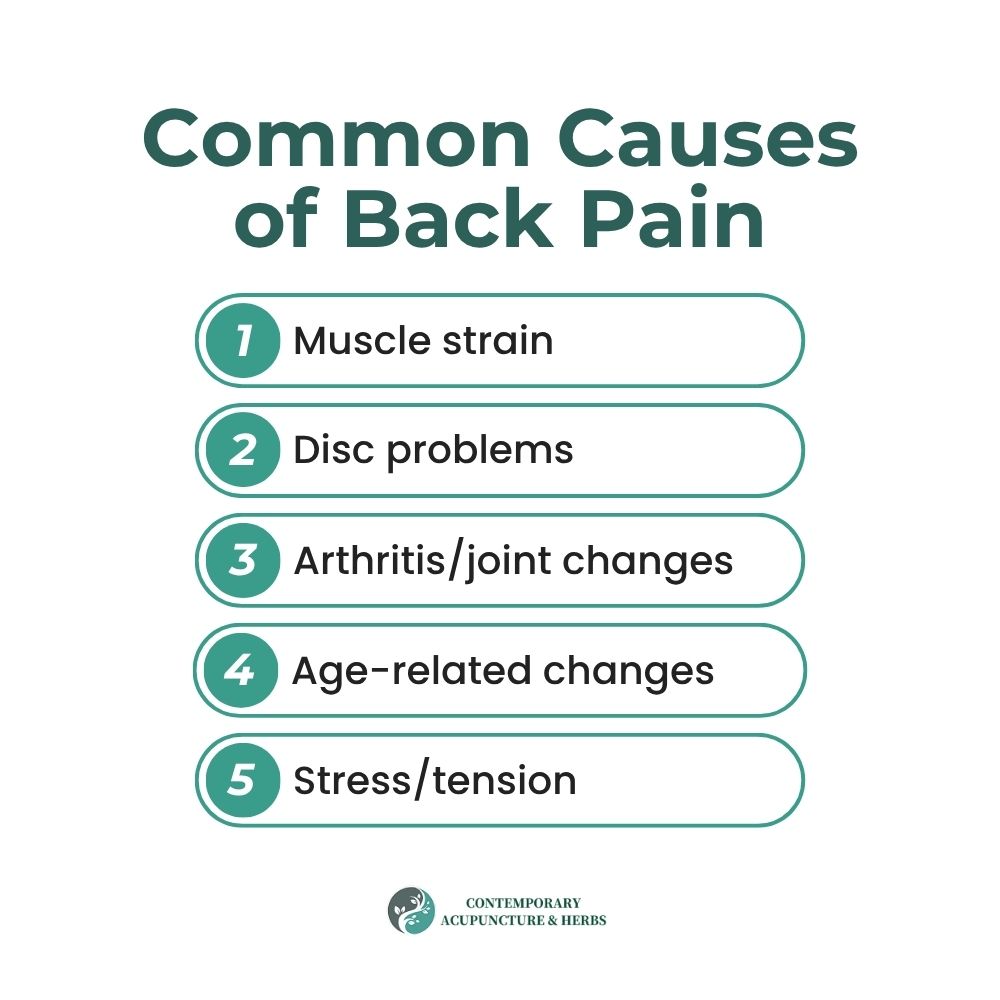
Back pain is one of the most frequent reasons people seek care, and it affects nearly every part of daily life. Whether it’s a dull ache that lingers after long hours at a computer or a sharp pain that makes simple movements difficult, the impact can be overwhelming.
Common causes of back pain include:
- Muscle strain or tension from posture and repetitive movements
- Disc problems such as herniated or bulging discs
- Arthritis and joint changes that affect the spine
- Age-related changes that naturally occur over time
- Stress and tension, which can tighten muscles and intensify discomfort
Because the causes are so varied, there isn’t a single solution that works for everyone. That’s why so many people look for care that addresses both the physical and underlying factors contributing to their pain.
Acupuncture has become a trusted option in this search, not only for easing discomfort but also for supporting overall balance and well-being.
What Is Acupuncture? Traditional and Modern Perspectives
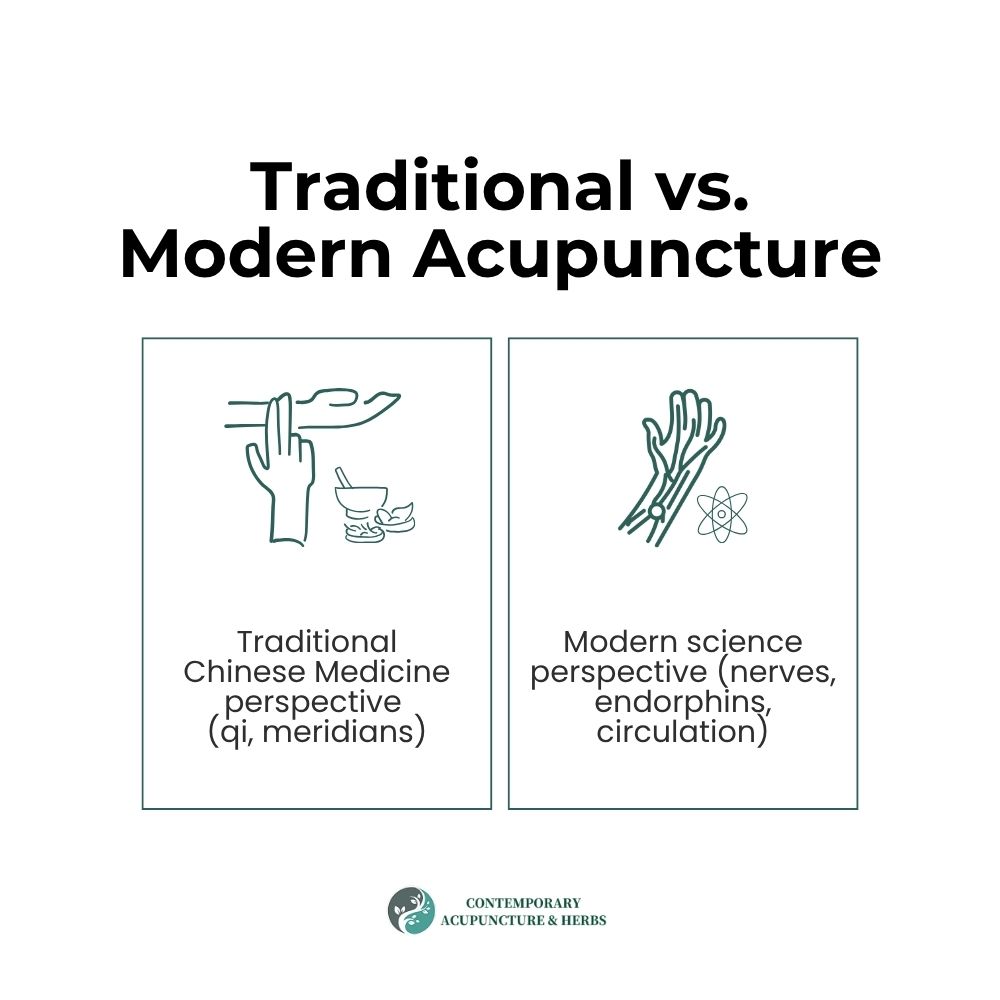
Acupuncture has been practiced for thousands of years and continues to evolve as both an ancient and modern form of care.
At its heart, it is a gentle treatment that uses very thin needles—or in some cases, needle-free stimulation—to encourage the body’s natural healing response.
From a traditional Chinese medicine (TCM) perspective:
- The body’s energy, known as qi, flows through pathways called meridians.
- When this energy becomes blocked or unbalanced, pain and illness may arise.
- Acupuncture restores the flow of qi, supporting balance and reducing discomfort.
From a Western scientific perspective:
- Acupuncture activates muscles, nerves, and connective tissue.
- This stimulation triggers the release of the body’s natural pain relievers, including endorphins and serotonin.
- It also improves blood circulation and calms areas of the nervous system that process pain.
Both perspectives point to the same outcome: helping the body reduce pain and regain balance.
Many of our patients find comfort in knowing acupuncture respects ancient wisdom while also being supported by today’s research.
How Acupuncture Relieves Back Pain: Mechanisms Explained

When we treat back pain with acupuncture, the goal is always twofold: to ease immediate discomfort and to support the body’s long-term healing process.
Research shows that acupuncture activates several mechanisms in the body that work together to reduce pain and promote recovery.
Here are some of the key ways acupuncture may help relieve back pain:
- Pain signal regulation – Needling specific points stimulates peripheral nerves, which send signals to the spinal cord and brain. This process helps “turn down the volume” of pain messages.
- Release of natural pain relievers – Acupuncture encourages the release of endorphins, serotonin, and dopamine, which ease pain and create a sense of well-being.
- Reduced inflammation – Studies suggest acupuncture can influence biochemical pathways that lower inflammation around muscles and joints.
- Improved circulation – By increasing blood flow to affected areas, acupuncture helps bring oxygen and nutrients that support healing.
- Brain activity changes – Imaging studies show acupuncture may alter activity in the parts of the brain that process pain, which can lead to lasting improvements in how pain is experienced.
Some of these effects may also be connected to the placebo response—the body’s natural ability to find relief when care feels supportive. But rather than diminishing acupuncture’s value, this highlights how powerful the mind-body connection truly is.
Research Evidence: Does Acupuncture Work for Back Pain?
We often meet people who wonder whether acupuncture truly helps with back pain or if any benefits are only short-lived. Over time, research has painted a more encouraging picture when used thoughtfully and alongside other healthy habits.
Supported by leading medical guidelines
The American College of Physicians recommends trying acupuncture as an early-care, non-drug option for both recent and long-standing low back pain. They place it alongside other gentle treatments like massage, heat therapy, and mindful movement before turning to medications.
What this means for you: Acupuncture appears on the same level as exercise or stress-reduction practices: safe, practical, and potentially effective without the drawbacks often tied to pain medications.
Why it matters: By offering a natural path to ease discomfort, acupuncture empowers many people to find relief without the risk of side effects, and often with a renewed sense of physical and emotional balance.
Beyond individual studies, a large 2018 Cochrane Review on acupuncture for chronic pain found that acupuncture provides moderate improvements in pain and function compared to no treatment, and small but meaningful benefits compared to sham acupuncture.
For some, results last several weeks or months, though many patients continue with maintenance sessions to sustain relief. This reinforces that while acupuncture is not a “cure,” it can be a valuable part of ongoing back pain management.
The overall picture is balanced: not every person will respond in the same way, but many find meaningful relief through acupuncture.
Even when improvements are modest, patients often appreciate that the therapy is natural, low-risk, and supportive of overall wellness.
What to Expect During Acupuncture for Back Pain
For many people, the first session can feel like a step into the unknown. We find that when patients know what to expect, they feel more comfortable and relaxed during treatment.
Here’s what typically happens when you come in for acupuncture for back pain:
- Initial consultation – We begin by listening carefully to your health history, daily habits, and the details of your back pain. This helps us create a treatment plan tailored to you.
- Placement of needles – Fine, sterile needles are gently inserted at specific points on the body. Most people describe the sensation as a light tingling, warmth, or heaviness that quickly fades.
- Relaxation time – Once the needles are in place, you’ll rest quietly for 20–40 minutes. Many patients find this part deeply calming—some even fall asleep.
- End of session – The needles are removed gently and painlessly. Most people leave feeling relaxed, sometimes noticing immediate relief or subtle changes in tension.
A full course of treatment often involves weekly sessions at first, then tapering as your symptoms improve. The number of visits needed varies, depending on whether pain is recent or has been present for many years.
For those who feel uneasy about needles, we also offer AcuWave Therapy, a needle-free option that provides similar benefits through gentle electrical stimulation of acupuncture points.
Ready to Try Acupuncture for Back Pain?
Every journey starts with a first step. Whether you’re new to acupuncture or exploring needle-free AcuWave Therapy, we’re here to make the experience gentle and effective for you.
Safety and Side Effects
One of the reasons so many people feel comfortable choosing acupuncture for back pain is its strong record of safety. When performed by a licensed acupuncturist, it is considered very low risk.
Most people experience little to no side effects. When they do occur, they are usually mild and short-lived, such as:
- Light soreness or a small bruise at the needle site
- Temporary fatigue or a sense of deep relaxation after the session
Serious complications are extremely rare, especially when treatment is provided in a professional clinic setting with sterile, single-use needles.
There are a few situations where extra care is needed: For example, if someone is pregnant, taking blood-thinning medication, or has a bleeding disorder. In these cases, it’s important to let us know so we can adjust the treatment safely.
Our goal is always to create a treatment plan that supports healing while keeping your comfort and well-being at the center of care.
Choosing a Qualified Acupuncturist
When it comes to acupuncture, the practitioner’s training and experience make all the difference. A qualified acupuncturist not only ensures safe treatment but also tailors each session to your unique needs.
Here are a few things to look for when choosing an acupuncturist for back pain:
- Licensing and certification – Confirm that your acupuncturist is licensed in your state and has completed accredited training.
- Experience with pain management – Ask if they specialize in musculoskeletal issues like back pain, since experience can guide more effective treatment.
- Clean and professional clinic setting – Treatment should always take place in a calm, hygienic environment using sterile, single-use needles.
- Personalized approach – Look for someone who listens carefully, explains the process clearly, and adapts sessions to your comfort level.
Finding the right practitioner creates trust and allows you to relax fully during treatment—a key part of the healing process.
Integrating Acupuncture Into a Holistic Back Pain Plan
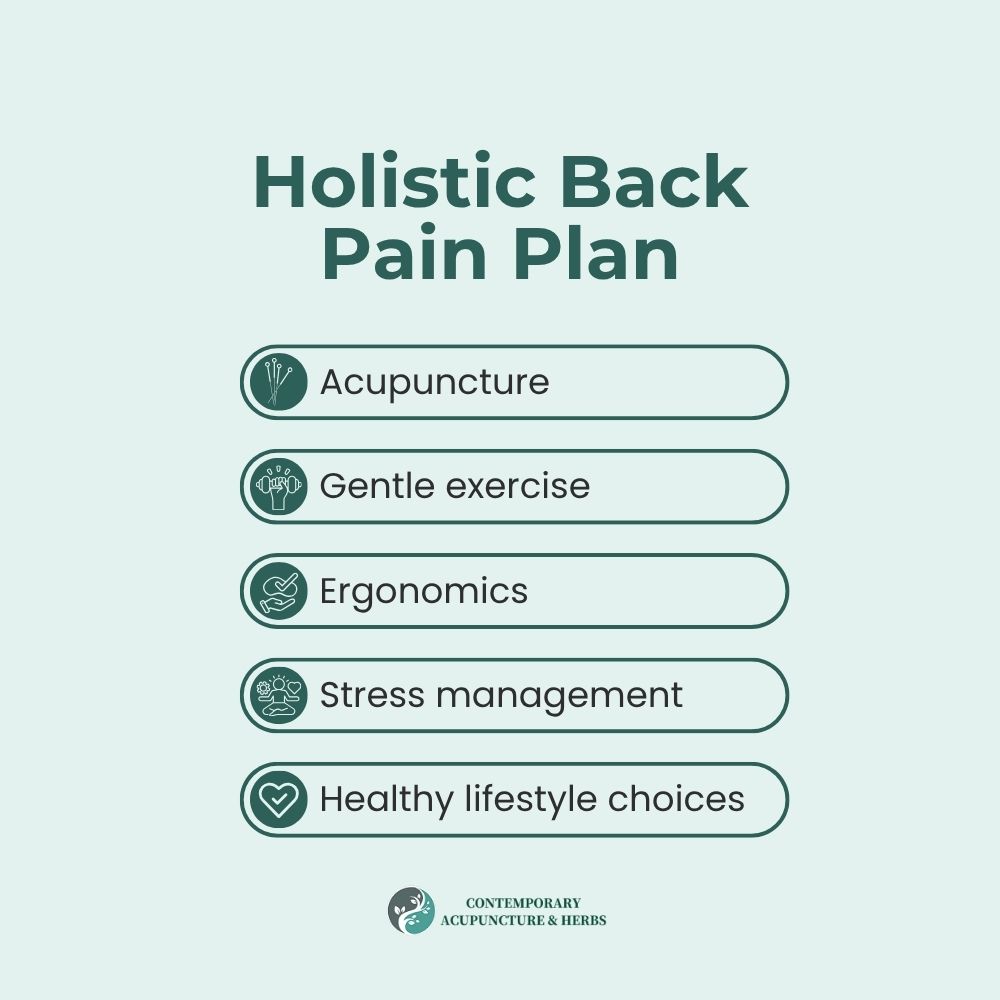
While acupuncture can provide meaningful relief on its own, many patients notice even greater improvements when it becomes part of a broader care plan.
Back pain is rarely caused by just one factor, so taking a whole-person approach often works best.
Alongside acupuncture, supportive strategies may include:
- Gentle movement and exercise – Activities such as stretching, yoga, or physical therapy help strengthen muscles and improve flexibility.
- Ergonomic adjustments – Simple changes like improving desk posture or using supportive seating can reduce daily strain on the spine.
- Stress management – Practices such as mindfulness, breathing exercises, or meditation help ease tension that often makes pain worse.
- Healthy lifestyle choices – Balanced nutrition, good sleep, and regular activity all support long-term back health.
Acupuncture complements these approaches by calming pain, reducing muscle tightness, and supporting balance in the body.
When combined, these strategies create a plan that not only relieves discomfort but also helps prevent it from returning.
Is Acupuncture Right for You?
Every person’s experience with back pain is unique, which means the best approach to care should be personal as well. Acupuncture may be a good fit if you are:
- Living with chronic low back pain that hasn’t fully improved with medications or standard therapies
- Looking for a non-drug option to manage discomfort safely
- Interested in a gentle, whole-body approach that supports both pain relief and overall wellness
- Hoping to avoid or delay more invasive treatments like injections or surgery
In some cases, it’s important to consult your doctor before beginning acupuncture, especially if you have severe pain, numbness, or other neurological symptoms. Together, you and your healthcare team can decide if acupuncture fits into your treatment plan.
It’s also important to understand what acupuncture does not do. While it can reduce pain, ease tension, and support healing, it cannot correct structural problems such as fractures, severe spinal damage, or advanced arthritis.
In these situations, acupuncture may still play a valuable role, helping manage discomfort during recovery or alongside other forms of medical care.
For many, choosing acupuncture is about finding a supportive, low-risk way to feel more comfortable, regain mobility, and return to daily life with greater ease.
Find Lasting Relief With Acupuncture for Back Pain
Living with back pain can feel exhausting, but you don’t have to manage it alone. Acupuncture offers a safe, evidence-based way to ease discomfort, restore balance, and support your body’s natural healing. Whether you’re seeking relief from long-term pain or looking for a supportive, non-drug option, our team is here to guide you with care.
At Contemporary Acupuncture, we provide both traditional acupuncture and needle-free AcuWave Therapy, giving you options that match your comfort level. Each session is designed with your well-being in mind, so you can move forward with greater ease and confidence.
Visit our clinic today and take the next step toward lasting relief.

